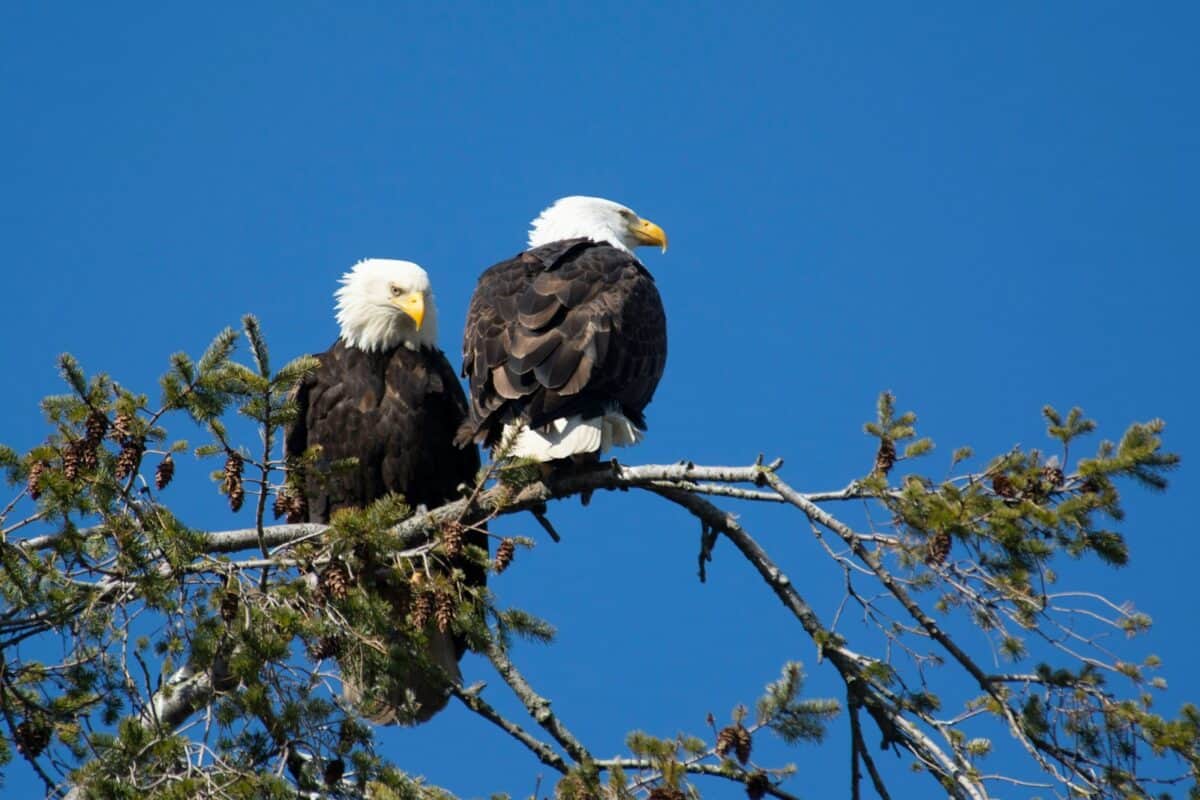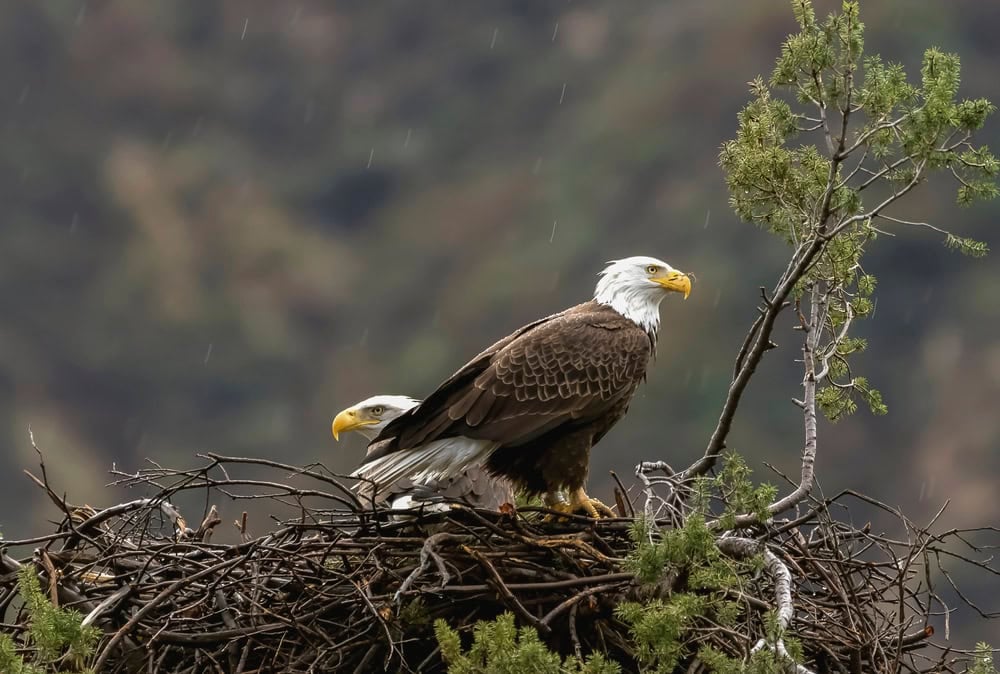Eagles, with their majestic presence and impressive wingspans, have long captured human imagination. While we often marvel at these birds soaring high above, their nesting habits remain somewhat mysterious to many. Eagle nests, called eyries, are engineering marvels that reveal fascinating aspects of these birds’ lives. From architectural prowess to family dynamics, eagle nesting behaviors demonstrate remarkable intelligence, dedication, and adaptation. The following insights into eagle nesting habits will deepen your appreciation for these magnificent birds and their remarkable approach to creating homes and raising families in the wild.
Record-Breaking Nest Dimensions

Eagle nests are among the largest structures built by any bird species, with some reaching truly astounding proportions. The largest documented bald eagle nest was discovered in St. Petersburg, Florida, measuring 9.5 feet in diameter and 20 feet deep, weighing more than 2 tons. Constructed over a 30-year period, this architectural wonder demonstrates eagles’ commitment to their nesting sites. Golden eagles build similarly impressive structures, with nests averaging 5-6 feet in diameter and 2 feet high, though they can grow substantially larger over years of use. These massive structures can sometimes become so heavy that they break the supporting branches or even topple entire trees, forcing the eagles to rebuild elsewhere.
Generational Property Inheritance

Unlike many bird species that build new nests each season, eagles often return to the same nest year after year, adding new materials with each breeding cycle. This practice creates a fascinating form of property inheritance across generations. When young eagles mature and seek territories of their own, they sometimes return to their natal areas and take over abandoned nests built by their parents or other eagles. Research has documented cases where eagle nests have been continuously occupied (though not always by the same individuals) for over 50 years. This generational reuse of nesting sites creates a unique architectural lineage rarely seen in other wildlife species, with each generation benefiting from and building upon the work of their predecessors.
Sophisticated Construction Techniques

Eagles employ remarkably sophisticated construction techniques when building their nests. They begin with a foundation of large sticks, some measuring up to 2 inches in diameter and 3 feet in length, which they interlock to create a sturdy base. As construction progresses, eagles add progressively smaller sticks, creating a structure that narrows toward the interior. The nest cup is then meticulously lined with soft materials including moss, grass, feathers, and even human-made items like rope or fabric when available. Particularly fascinating is how eagles test potential nest materials by applying weight to branches before breaking them off trees, demonstrating a practical understanding of structural integrity. Additionally, eagles incorporate fresh, aromatic greenery into their nests, which some researchers believe may serve as natural insect repellents, showcasing a form of natural pest management.
Strategic Location Selection

Eagles display remarkable selectivity when choosing nest locations, considering multiple factors that enhance both survival and hunting efficiency. Bald eagles typically select tall, mature trees that provide clear sightlines to water bodies, positioning their nests in the upper canopy to afford unobstructed views of potential threats and prey. A comprehensive study of bald eagle nesting preferences across North America found that 99% of nests were located within 2 miles of water, with an average distance of just 0.5 miles. Golden eagles, conversely, often build nests on cliff ledges or rocky outcrops in mountainous or hilly terrain, sometimes at elevations exceeding 10,000 feet. Both species show a marked preference for locations that combine limited human disturbance, proximity to food sources, and protection from severe weather—demonstrating an intuitive understanding of habitat quality that rivals the most sophisticated human housing assessments.
Year-Round Nest Maintenance

While many birds attend to their nests only during breeding season, eagles engage in nest maintenance throughout the year. Even during non-breeding periods, eagles regularly visit their nests to make repairs and add new materials. This ongoing maintenance serves multiple purposes beyond simple upkeep. Regular visits help pairs reestablish and strengthen their bond to both the territory and each other. The continuous addition of materials helps compensate for decomposition and weather damage, ensuring the nest remains structurally sound. Researchers studying nest maintenance behaviors have observed eagles making repairs within hours of storm damage, suggesting they actively monitor their nests’ conditions. This year-round commitment to home maintenance reflects the significant investment eagles make in their nesting sites and helps explain how these structures can grow to such impressive dimensions over time.
Multi-Nest Territory Systems

Contrary to popular belief, many eagle pairs maintain multiple nests within their territories, rotating between them over different breeding seasons. Studies of bald eagles in the Chesapeake Bay region revealed that established pairs maintained an average of 1.5 to 3 nests within their territories. This strategy provides important advantages, allowing eagles to abandon nests that become infested with parasites or structurally compromised without surrendering their valuable territory. Having alternate nests also enables eagles to respond to changing environmental conditions, such as selecting more sheltered nests during particularly harsh weather years. Some pairs have been observed using different nests in alternating years in a regular pattern, suggesting a deliberate rotation system that may serve to break parasite life cycles. This sophisticated territory management demonstrates eagles’ long-term planning capabilities and adaptability to changing conditions.
Cooperative Parental Investment

Eagle partners display remarkable cooperation throughout the nesting process, sharing responsibilities in ways that maximize offspring survival. Unlike many bird species where nest-building falls primarily to one sex, both male and female eagles contribute substantially to construction and maintenance. During the 4-6 week nest-building period, partners often synchronize their efforts, with one gathering materials while the other arranges them into the structure. This teamwork continues during incubation, with partners taking shifts to maintain optimal egg temperature while allowing each other opportunities to hunt. A study of bald eagles in Alaska found that females typically handle about 70% of incubation duties, but males reliably take over when their partners leave the nest. This balanced division of labor represents one of nature’s most equitable parenting arrangements and contributes significantly to the species’ reproductive success across diverse and often challenging environments.
Nest Temperature Regulation

Eagles have developed sophisticated techniques to regulate nest temperatures across extreme weather conditions, protecting their eggs and young from both hypothermia and overheating. During cold weather, eagles use their bodies as living insulators, covering eggs and nestlings with their specially adapted brood patch—a featherless area on their underbelly with increased blood vessels that transfers body heat efficiently. Conversely, during hot weather, eagles have been observed bringing water-soaked nesting materials to the nest, using evaporative cooling to reduce temperatures. They also adjust their posture to create shade for vulnerable nestlings, sometimes standing over them with wings partially extended to maximize cooling. Research using thermal imaging has documented temperature gradients of up to 20°F between ambient air and nest interiors during extreme weather, demonstrating the effectiveness of these regulatory behaviors. This temperature management capability allows eagles to successfully raise young across remarkably diverse climates, from the frozen Alaskan wilderness to the subtropical wetlands of Florida.
Architectural Adaptations to Environment

Eagle nests show remarkable adaptations to local environmental conditions, with variations in structure and materials reflecting specific regional challenges. In windy coastal areas, bald eagles often build deeper, more bowl-shaped nests with tighter stick weaving patterns that resist wind displacement. Eagles nesting in regions with heavy precipitation typically incorporate more efficient drainage systems, creating nests with slight depressions off-center rather than in the middle, allowing water to channel away from eggs and nestlings. In arid environments, golden eagles have been observed incorporating more rock material into their nests, creating thermal mass that moderates temperature fluctuations between hot days and cool nights. Perhaps most impressive, eagles in areas with high predator densities tend to build nests with steeper outer walls and more pronounced overhangs, creating defensive architecture that deters climbing predators. These adaptations demonstrate not just instinctive building behaviors but a sophisticated ability to respond to specific environmental challenges through architectural modifications.
Fascinating Nest Adornments

Eagles often incorporate unusual and seemingly non-functional items into their nests, creating collections that puzzle researchers and fascinate observers. Marine biologists examining bald eagle nests along coastlines have documented items including fishing lures, plastic toys, golf balls, and in one well-documented case, a camera that still contained viewable photographs. While some researchers suggest these items may be mistaken for useful nesting materials, others propose they serve as territorial markers or even play objects for nestlings. Golden eagles are particularly known for decorating their nests with unusual found objects, including antlers, bones, and human artifacts. One study in Wyoming documented artificial objects in 7.5% of golden eagle nests surveyed, including unusual items like strips of plastic surveyor’s tape and aluminum foil. Some eagle specialists theorize these objects may serve as visual stimulation for developing eaglets, similar to how human parents provide toys for cognitive development.
Nest Defense Strategies

Eagles employ sophisticated and coordinated defense strategies to protect their nests from threats, demonstrating both courage and tactical intelligence. Their primary defense involves establishing buffer zones of increasing aggression. At distances of approximately 750-1500 feet from the nest, eagles typically begin with warning behaviors, including distinctive alarm calls and conspicuous perching. As threats approach within 300-750 feet, eagles escalate to direct flights toward intruders, often circling overhead in intimidating displays. Within 300 feet of the nest, many eagles transition to active defense, including dramatic diving attacks (known as stooping) that can reach speeds over 100 mph. Partners frequently coordinate these defense efforts, with one bird creating a distraction while the other executes more direct confrontation tactics. Remarkably, eagles appear to calibrate their response based on the nature of the threat, responding more aggressively to predators capable of nest raiding than to non-threatening species. This tiered defense system reflects a sophisticated risk assessment capability that maximizes protection while conserving energy for the demanding task of raising young.
Nest Cameras Reveal Unexpected Behaviors

The proliferation of high-definition nest cameras in recent decades has revolutionized our understanding of eagle nesting behaviors, revealing previously unknown aspects of their private lives. One of the most surprising discoveries has been eagles’ nighttime activity levels, with footage showing parents regularly rearranging nesting materials, feeding young, and adjusting positions throughout the night—behaviors impossible to observe through traditional research methods. Cameras have also documented unexpected dietary diversity, with bald eagles bringing not just fish but mammals, birds, and reptiles to nests, sometimes including surprising prey like domestic cats and waterfowl. Perhaps most fascinating has been footage revealing complex family dynamics, including subtle communication methods between partners and apparent “teaching moments” where parents demonstrate specific behaviors for eaglets to imitate. Cameras in Minnesota captured adult eagles appearing to demonstrate proper fish handling techniques to nestlings before allowing them to feed independently. These intimate glimpses into eagle family life have not only advanced scientific understanding but have created passionate online communities of eagle nest followers who contribute valuable observational data to research efforts.
Nest-Building as Courtship

Nest construction serves as a crucial component of eagle courtship and pair bonding, functioning as both practical preparation for breeding and symbolic relationship reinforcement. Young eagles seeking mates often begin building starter nests or renovating abandoned ones before they have secured a partner, using these structures as visual advertisements of their territory claims and nest-building skills. During early courtship, potential partners engage in synchronized building behaviors, where their coordination and cooperation serve as compatibility tests. Researchers have observed that successful pairs develop distinctive building rhythms, with partners anticipating each other’s movements and seamlessly alternating tasks. The process incorporates spectacular aerial displays, with eagles sometimes passing sticks mid-flight or performing acrobatic maneuvers while carrying nesting materials. These dramatic demonstrations combine practical nest construction with courtship display, creating multi-purpose behaviors that simultaneously advance both relationship development and nest completion. For established pairs, annual nest refurbishment serves as relationship renewal, with studies showing increased hormonal synchronization between partners during building activities, physiologically reinforcing their bond.
Nests as Ecosystem Hubs

Eagle nests function as remarkable biodiversity hotspots, creating microecosystems that support numerous other species. The massive structures provide shelter, nesting sites, and foraging opportunities for a diverse community of animals. Studies examining bald eagle nests have identified over 55 different arthropod species living within a single nest, including specialized detritivores that break down food remains and specialized parasites that have evolved to feed specifically on eagle blood. The base and periphery of large eagle nests frequently host smaller bird nests, with species like European starlings, house sparrows, and even other raptors like kestrels building homes in the supportive structure. Below active nests, the continuous deposition of prey remains, droppings, and fallen nesting materials creates nutrient-rich zones that support distinctive plant communities. Research in the Pacific Northwest has documented significantly higher soil nitrogen levels beneath long-established eagle nests, supporting unusually lush vegetation. When nests are eventually abandoned, they often become long-term shelter for mammals ranging from squirrels to raccoons, extending their ecological impact for years. This community-building aspect of eagle nests represents a fascinating example of how apex predators can function as ecosystem engineers, creating habitat that supports biodiversity throughout the food web.
Climate Change Impacts on Nesting Habits

Eagle nesting behaviors are undergoing observable changes in response to climate shifts, providing visible indicators of broader ecological transformations. Researchers tracking nesting chronology across North America have documented that bald eagles in many regions are initiating nest building and egg-laying approximately 5-15 days earlier than they did in the 1970s, corresponding to warming spring temperatures. This timing shift creates potential misalignment with traditional prey availability patterns, forcing some eagle populations to adapt their hunting strategies or target different prey species. More dramatic climate impacts include increasing nest failures in regions experiencing more frequent extreme weather events, with severe storms in the southeastern United States destroying up to 30% of nests in affected areas during particularly active hurricane seasons. Eagles are responding with observable adaptations, including building more structurally robust nests with deeper anchoring systems in storm-prone regions and selecting more sheltered nest sites in areas experiencing increasing temperature extremes. Long-term monitoring suggests eagles’ remarkable behavioral plasticity may allow them to adapt to moderate climate changes, though the pace of current shifts presents unprecedented challenges that test the limits of their adaptive capabilities.
Eagle Nesting A Testament to Avian Intelligence and Adaptation

The complex nesting behaviors of eagles represent one of nature’s most impressive demonstrations of avian intelligence, physical capability, and evolutionary adaptation. From the architectural achievement of creating the animal kingdom’s largest bird nests to the sophisticated social coordination between partners, eagle nesting practices reveal cognitive and behavioral complexity that challenges our understanding of bird intelligence. The multi-generational nature of eagle nests creates living monuments that connect past, present, and future generations of these magnificent birds across decades of continuous use and modification. As human activity continues to transform landscapes and climate patterns shift nesting conditions, eagles demonstrate remarkable resilience through behavioral adaptations that allow them to persist despite significant challenges. By deepening our understanding of these fascinating nesting habits, we gain not only scientific insight but also a greater appreciation for the extraordinary lives of these iconic birds that have symbolized power, freedom, and natural majesty throughout human history.
Conclusion:

Eagle nests are far more than simple shelters—they are dynamic, evolving structures that reflect the intelligence, adaptability, and deep social bonds of their builders. From their record-breaking size and multi-generational use to their role as biodiversity hubs and tools of courtship, these nests reveal eagles as master architects and devoted parents. The intricate strategies they use to construct, maintain, and defend their homes underscore a level of behavioral sophistication that continues to astonish researchers and nature lovers alike. As climate change and human encroachment alter the natural world, the resilience and ingenuity shown in eagle nesting habits offer both inspiration and a poignant reminder of what is at stake. In understanding the complexity of their nesting lives, we gain not only scientific knowledge but a deeper respect for the powerful connection between these iconic birds and the wild places they call home.
- 13 Surprising Animals Thriving in Urban America - August 23, 2025
- 13 Common Birdwatching Mistakes and How to Fix Them - August 23, 2025
- 12 Reasons Why Orcas Are More Dangerous Than Great White Sharks - August 23, 2025

